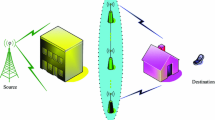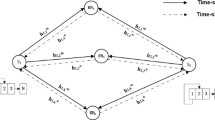Abstract
Due to the rapidly increasing energy consumption of the wireless communication systems, designing an energy-efficient system has become an important challenge. One can consider cooperative communication as a promising solution to reduce energy consumed by wireless networks. Hence, in this paper, we study the problem of maximizing energy efficiency by optimally allocating power in three cooperative channel scenarios. Unlike the previous works, imperfect channel state information is considered for all channels. Therefore, energy efficiency functions are derived considering channel estimation errors, and the following optimization problems are formulated to maximize the energy efficiency under the maximum transmission power and the minimum spectral efficiency constraints. Regarding the energy efficiency function behavior, an alternating optimization algorithm is used to find pilot and data transmission power at the source node. It also optimizes the power amplification gain of pilot and data at the relay node. Simulation results demonstrate that the imperfect channel state information condition can degrade the energy efficiency performance significantly. However, using the proposed power allocation method can improve the performance and compensate for the negative effect of channel estimation error. Moreover, the effect of circuit power on the optimal energy efficiency is investigated. It is shown that for a lower range of spectral efficiency, the negative effect of circuit power is greater than the channel estimation error’s negative effect, while for the higher values, the estimation error dominates the circuit power. We also observe that the results obtained from the proposed power allocation algorithms are close to the results of the global search method.











Similar content being viewed by others
References
Zujun, L., Li, J., & Sun, D. (2017). Circuit power consumption-unaware energy efficiency optimization for massive MIMO systems. IEEE Wireless Communications Letters, 6, 370–373.
Guowang, M., et al. (2009). Cross-layer optimization for energy-efficient wireless communications: A survey. Wireless Communications and Mobile Computing, 9, 529–542.
Boccardi, F., Heath, R. W., Lozano, A., Marzetta, T. L., & Popovski, P. (2014). Five disruptive technology directions for 5G. IEEE Communication Magazine, 52, 74–80.
Chen, H., Li, G., & Cai, J. (2015). Spectral-energy efficiency tradeoff in full-duplex two-way relay networks. IEEE Systems Journal, 12, 583–592.
Ahmad, M., Orakzai, F. A., Ahmed, A., et al. (2019). Energy efficiency in cognitive radio assisted D2D communication networks. Telecommunication Systems, 71, 167–180.
Li, H., Song, L., & Debbah, M. (2014). Energy efficiency of large-scale multiple antenna systems with transmit antenna selection. IEEE Transactions on Communications, 62, 638–647.
Guowang, M., Himayat, N., & Li, G. Y. (2010). Energy-efficient link adaptation in frequency-selective channels. IEEE Transactions on communications, 58, 545–554.
Guo, S., Shi, Y., Yang, Y., & Xiao, B. (2018). Energy efficiency maximization in mobile wireless energy harvesting sensor networks. IEEE Transactions on Mobile Computing, 17, 1524–1537.
Cong, X., et al. (2011). Energy-and spectral-efficiency tradeoff in downlink OFDMA networks. IEEE Transactions on Wireless Communications, 10, 3874–3886.
Khalil, M., Barber, S., & Sworby, K. (2018). High energy efficiency for low error rate in wireless relay networks. IET Signal Processing, 5, 659–665.
Sun, C., & Yang, C. (2012). Energy efficiency analysis of one-way and two-way relay systems. EURASIP Journal on Wireless Communications and Networking, 2012, 46.
Sharma, E., et al. (2018). Full-duplex massive MIMO multi-pair two-way AF relaying: Energy efficiency optimization. IEEE Transactions on Communications, 66, 3322–3340.
Chinaei, M. H., et al. (2016). Energy efficiency optimization of one-way and two-way DF relaying considering circuit power. Wireless Networks, 22, 367–381.
Cao, Y., Jiang, T., & Wang, C. (2015). Cooperative device-to-device communications in cellular networks. IEEE Wireless Communications, 22, 124–129.
Viet-Anh, L., et al. (2010). Green cooperative communication using threshold-based relay selection protocols. In IEEE International Conference on Green Circuits and Systems (ICGCS) (pp. 521–526).
Huang, S., et al. (2013). Energy efficiency and spectral-efficiency tradeoff in amplify-and-forward relay networks. IEEE Transactions on Vehicular Technology, 62, 4366–4378.
Tabataba, F. S., Sadeghi, P., Hucher, Ch., & Pakravan, M. R. (2012). Impact of channel estimation errors and power allocation on analog network coding and routing in two-way relaying. IEEE Transactions on Vehicular Technology, 61, 3223–3239.
Yu, H., et al. (2013). The analysis of the energy efficiency for the decode-and-forward two-way relay networks. In IEEE Wireless Communications and Networking Conference (WCNC) (pp. 2823–2827).
Chen, H., Li, G., & Cai, J. (2018). Spectral-energy efficiency tradeoff in full-duplex two-way relay networks. IEEE Systems Journal, 12, 583–592.
Pashazadeh, M., & Tabataba, F. S. (2017). Impact of loop-back interference and channel estimation errors on full-duplex relay networks. Wireless Networks, 23, 1133–1143.
Zhang, J., & Haardt, M. (2015). Energy efficient two-way non-regenerative relaying for relays with multiple antennas. IEEE Signal Processing Letters, 22, 1079–1083.
Silva, S., et al. (2018). Performance analysis of massive MIMO two-way relay networks with pilot contamination. Imperfect CSI, and Antenna Correlation, IEEE Transactions on Vehicular Technology, 67, 4831–4842.
Zappone, A., Buzzi, S., & Jorswieck, E. (2011). Energy-efficient power control and receiver design in relay-assisted DS/CDMA wireless networks via game theory. IEEE Communications Letters, 15, 701–703.
Zappone, A., et al. (2013). Energy-aware competitive power control in relay-assisted interference wireless networks. IEEE Transactions on Wireless Communications, 12, 1860–1871.
Gao, Y., & Chen, Y. (2018). Channel estimation for AF relaying using ML and MAP. Wireless Networks, 24, 3161–3170.
Nguyen, V. D., & Shin, O. S. (2017). Performance analysis of ZF receivers with imperfect CSI for uplink massive MIMO systems. Telecommunication Systems, 65, 241–252.
Bezdek, J. C., & Hathaway, R. J. (2002). Some notes on alternating optimization. In AFSS international conference on fuzzy systems (Vol. 4, pp. 288–300). Springer, Berlin, Heidelberg.
Rappaport, T. S. (2002). Wireless communications-principles and practice. Upper Saddle River: Prentice Hall.
Patel, C. S., & Stuber, G. L. (2007). Channel estimation for amplify and forward relay-based cooperation diversity systems. IEEE Transactions on Wireless Communications, 6, 2348–2356.
Yadav, S. (2018). Three-phase two-way relaying with imperfect channel estimation and asymmetric traffic requirements: Performance analysis and optimization. Wireless Networks, 25, 3133–3147.
Jiang, B., Gao, F., Gao, X., & Nallanathan, A. (2010). Channel estimation and training design for two-way relay networks with power allocation. IEEE Transactions on Wireless Communications, 9, 2022–2032.
Tabataba, F. S., Sadeghi, P., & Pakravan, M. R. (2011). Outage probability and power allocation of amplify and forward relaying with channel estimation errors. IEEE Transactions on Wireless Communications, 10, 124–134.
Kroese, D. P., Thomas, T., & Zdravko, I. B. (2013). Handbook of Monte Carlo methods. Hoboken: Wiley.
Author information
Authors and Affiliations
Corresponding author
Additional information
Publisher's Note
Springer Nature remains neutral with regard to jurisdictional claims in published maps and institutional affiliations.
Rights and permissions
About this article
Cite this article
Tabataba, F.S., Rouhani, P. & Koolivand, M. Energy efficiency optimization for amplify and forward relay networks with channel estimation errors. Telecommun Syst 76, 541–552 (2021). https://doi.org/10.1007/s11235-020-00730-5
Accepted:
Published:
Issue Date:
DOI: https://doi.org/10.1007/s11235-020-00730-5




